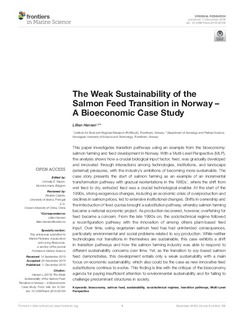| dc.description.abstract | This paper investigates transition pathways using an example from the bioeconomy: salmon farming and feed development in Norway. With a Multi-Level Perspective (MLP), the analysis shows how a crucial biological input factor, feed, was gradually developed and innovated through interactions among technologies, institutions, and landscape (external) pressures, with the industry’s ambitions of becoming more sustainable. The case story presents the start of salmon farming as an example of an incremental transformation pathway with gradual reorientations in the 1960s’, where the shift from wet feed to dry, extruded feed was a crucial technological enabler. At the start of the 1990s, strong exogenous changes, including an economic crisis of overproduction and declines in salmon prices, led to extensive institutional changes. Shifts in ownership and the introduction of feed quotas brought a substitution pathway, whereby salmon farming became a national economic project. As production recovered, however, overfishing for feed became a concern. From the late 1990s on, the sociotechnical regime followed a reconfiguration pathway with the innovation of among others plant-based feed input. Over time, using vegetarian salmon feed has had unintended consequences, particularly environmental and social problems related to soy production. While neither technologies nor transitions in themselves are sustainable, this case exhibits a shift in transition pathways and how the salmon farming industry was able to respond to different sustainability concerns over time. Yet, as the transition to soy-based salmon feed demonstrates, this development entails only a weak sustainability with a main focus on economic sustainability, which also could be the case as new innovative feed substitutions continue to evolve. This finding is line with the critique of the bioeconomy agenda for paying insufficient attention to environmental sustainability and for failing to challenge predominant structures in society. | nb_NO |

